A System Optimization Approach for Trains’ Operation Plan with a Time Flexible Pricing Strategy for High-Speed Rail Corridors
Abstract
:1. Introduction
- Applying flexible pricing to guide the passengers’ travel choices reasonably on high-speed rail is shown in Section 3.2.
- Bilevel programming is used to describe the dynamic feedback process of decision-making between the railway enterprise and passengers, and the improved genetic algorithm and Frank–Wolfe algorithm are used to realize the solution of the double-layer programming model, as shown in Section 4 and Section 5.
- Applying a multiple OD flow distribution in high-speed rail via the establishment of a high-speed rail service network is shown in Section 3.3 and Section 4.2.
2. Literature Review
3. Problem Analysis
3.1. Related Assumptions and Notation
- Passengers will not get off and transfer to a later train before arriving at the destination station once they take a certain train.
- In a given high-speed rail corridor, all trains have the same hardware parameters and leave at equal intervals within the same time period.
- Before moving further, we list the major notations in Table 1.
3.2. Problem Description
3.3. Passenger Travel Service Network
3.3.1. High-Speed Rail Service Network
3.3.2. Departure Arc
3.3.3. In-Node Arc
3.3.4. In-Train Arc
3.3.5. Generalized Travel Costs
4. Construction of the Bilevel Programming Model
4.1. Upper-Level Planning Model
- Departure capacity constraint
- Passenger flow demand constraint
- Ticket fare constraints
- Decision variable constraints
4.2. Lower-Level Programming Model
- Passenger flow balance constraint
- Demand constraint
- Decision variable constraint
5. Solution Algorithm
5.1. Upper Layer Algorithm
5.2. Lower Layer Algorithm
6. Numerical Experiment
6.1. Experiment Scenario
6.2. Setting the Parameters
6.3. Analysis of the Results
7. Conclusions
- (1)
- This article has constructed a generalized travel cost function for passengers, which defines the convenience of passengers based on factors such as geographic location and regional economic level. It also takes into account the different experiences that passengers may have due to the level of crowding on the train and adjusts the ticket price accordingly. The article evaluates the convenience and comfort of passenger travel more comprehensively, providing ideas for the formulation of railway ticket pricing.
- (2)
- Passengers have different preferences for different travel periods. The transfer of railway passengers during each travel period results in changes in the travel cost of each path for the same OD. Based on Wardrop Equilibrium, this paper achieves a UE equilibrium state when the impedances are equal, at which time the total travel cost of passengers is minimal.
- (3)
- A flexible pricing strategy based on time slot passenger flow proposed in this paper increases the broad travel cost of passengers during peak periods by increasing fares and shifting the passenger flow from peak periods to low periods, relieving the pressure on railway operations during peak periods and improving the travel experience of passengers.
- (4)
- The bi-level programming model used in this paper ensures that railway revenue is maximized and total passenger travel costs are minimized and equal. While increasing the revenue of railway companies, it also satisfies passengers to spend less and improves passenger satisfaction.
Author Contributions
Funding
Institutional Review Board Statement
Informed Consent Statement
Data Availability Statement
Acknowledgments
Conflicts of Interest
References
- Yang, W.; Chen, Q.; Yang, J. Factors Affecting Travel Mode Choice between High-Speed Railway and Road Passenger Transport—Evidence from China. Sustainability 2022, 14, 15745. [Google Scholar] [CrossRef]
- Li, H.; Li, X.; Xu, X.; Liu, J.; Ran, B. Modeling departure time choice of metro passengers with a smart corrected mixed logit model—A case study in Beijing. Transp. Policy 2018, 69, 106–121. [Google Scholar] [CrossRef]
- Wang, X.; Wang, H.; Zhang, X. Stochastic seat allocation models for passenger rail transportation under customer choice. Transp. Res. Part E Logist. Transp. Rev. 2016, 96, 95–112. [Google Scholar] [CrossRef]
- Wang, J.; Zhou, W.; Li, S.; Shan, D. Impact of personalised route recommendation in the cooperation vehicle-infrastructure systems on the network traffic flow evolution. J. Simul. 2018, 13, 239–253. [Google Scholar] [CrossRef]
- Zhang, P.; Ding, R.; Zhao, W.; Zhang, L.; Sun, H. Passenger Travel Path Selection Based on the Characteristic Value of Transport Services. Sustainability 2023, 15, 636. [Google Scholar] [CrossRef]
- Wang, Y.; Tang, T.; Ning, B.; van den Boom, T.J.J.; De Schutter, B. Passenger-demands-oriented train scheduling for an urban rail transit network. Transp. Res. Part C Emerg. Technol. 2015, 60, 1–23. [Google Scholar] [CrossRef]
- Kim, K.M.; Hong, S.-P.; Ko, S.-J.; Kim, D. Does crowding affect the path choice of metro passengers? Transp. Res. Part A Policy Pract. 2015, 77, 292–304. [Google Scholar] [CrossRef]
- Wang, J.; Niu, H. A distributed dynamic route guidance approach based on short-term forecasts in cooperative infrastructure-vehicle systems. Transp. Res. Part D Transp. Environ. 2019, 66, 23–34. [Google Scholar] [CrossRef]
- Mitropoulos, L.; Kortsari, A.; Mizaras, V.; Ayfantopoulou, G. Mobility as a Service (MaaS) Planning and Implementation: Challenges and Lessons Learned. Future Transp. 2023, 3, 498–518. [Google Scholar] [CrossRef]
- Khoshniyat, F.; Peterson, A. Improving train service reliability by applying an effective timetable robustness strategy. J. Intell. Transp. Syst. 2017, 21, 525–543. [Google Scholar] [CrossRef]
- Gabor, M.R.; Kardos, M.; Oltean, F.D. Yield Management—A Sustainable Tool for Airline E-Commerce: Dynamic Comparative Analysis of E-Ticket Prices for Romanian Full-Service Airline vs. Low-Cost Carriers. Sustainability 2022, 14, 15150. [Google Scholar] [CrossRef]
- Qin, J.; Qu, W.; Wu, X.; Zeng, Y. Differential Pricing Strategies of High Speed Railway Based on Prospect Theory: An Empirical Study from China. Sustainability 2019, 11, 3804. [Google Scholar] [CrossRef] [Green Version]
- Zhang, X.; Ma, L.; Zhang, J. Dynamic pricing for passenger groups of high-speed rail transportation. J. Rail Transp. Plan. Manag. 2017, 6, 346–356. [Google Scholar]
- Chou, J.-S.; Chien, Y.-L.; Nguyen, N.-M.; Truong, D.-N. Pricing policy of floating ticket fare for riding high speed rail based on time-space compression. Transp. Policy 2018, 69, 179–192. [Google Scholar] [CrossRef]
- Sato, K.; Sawaki, K. Dynamic pricing of high-speed rail with transport competition. J. Revenue Pricing Manag. 2011, 11, 548–559. [Google Scholar] [CrossRef]
- Tang, Z.; Qin, J.; Liu, H.; Du, X.; Sun, J. Optimal decisions of sharing rate and ticket price of different transportation modes in inter-city transportation corridor. J. Ind. Eng. Manag. 2015, 8, 1731–1745. [Google Scholar] [CrossRef] [Green Version]
- Zhang, X.; Luan, W.; Cai, Q.; Zhao, B. Research on Dynamic Pricing Between High Speed Rail and Air Transport under the Influence of Induced Passenger Flow. Inf. Technol. J. 2012, 11, 431–435. [Google Scholar]
- Zhang, X.; Li, L.; Le Vine, S.; Liu, X. An integrated pricing/planning strategy to optimize passenger rail service with uncertain demand. J. Intell. Fuzzy Syst. 2019, 36, 435–448. [Google Scholar] [CrossRef]
- Zheng, J.; Liu, J. The Research on Ticket Fare Optimization for China’s High-Speed Train. Math. Probl. Eng. 2016, 2016, 5073053. [Google Scholar] [CrossRef] [Green Version]
- Jin, F.L.; Tian, W.Q.; Wang, L. High-speed railway passenger flow equilibrium among trains of common lines based on travel behavior analysis under dynamic pricing. Transp. Lett. Int. J. Transp. Res. 2022, 1–16. [Google Scholar] [CrossRef]
- Yin, X.; Liu, D.; Rong, W.; Li, Z. Joint Optimization of Ticket Pricing and Allocation on High-Speed Railway Based on Dynamic Passenger Demand during Pre-Sale Period: A Case Study of Beijing–Shanghai HSR. Appl. Sci. 2022, 12, 10026. [Google Scholar] [CrossRef]
- Xu, X.; Xie, L.; Li, H.; Qin, L. Learning the route choice behavior of subway passengers from AFC data. Expert Syst. Appl. 2018, 95, 324–332. [Google Scholar] [CrossRef]
- Zhou, W.; Zou, Z.; Chai, N.; Xu, G. Optimization of Differential Pricing and Seat Allocation in High-Speed Railways for Multi-Class Demands: A Chinese Case Study. Mathematics 2023, 11, 1412. [Google Scholar] [CrossRef]
- Hamdouch, Y.; Ho, H.W.; Sumalee, A.; Wang, G. Schedule-based transit assignment model with vehicle capacity and seat availability. Transp. Res. Part B Methodol. 2011, 45, 1805–1830. [Google Scholar] [CrossRef]
- Li, W.; Zhu, W. A dynamic simulation model of passenger flow distribution on schedule-based rail transit networks with train delays. J. Traffic Transp. Eng. (Eng. Ed.) 2016, 3, 364–373. [Google Scholar] [CrossRef] [Green Version]
- Sun, S.; Szeto, W. Logit-based transit assignment: Approach-based formulation and paradox revisit. Transp. Res. Part B Methodol. 2018, 112, 191–215. [Google Scholar] [CrossRef]
- Fu, Q.; Liu, R.; Hess, S. A Review on Transit Assignment Modelling Approaches to Congested Networks: A New Perspective. Procedia-Soc. Behav. Sci. 2012, 54, 1145–1155. [Google Scholar] [CrossRef] [Green Version]
- Binder, S.; Maknoon, Y.; Bierlaire, M. Exogenous priority rules for the capacitated passenger assignment problem. Transp. Res. Part B Methodol. 2017, 105, 19–42. [Google Scholar] [CrossRef]
- Barrena, E.; Canca, D.; Coelho, L.C.; Laporte, G. Single-line rail rapid transit timetabling under dynamic passenger demand. Transp. Res. Part B Methodol. 2014, 70, 134–150. [Google Scholar] [CrossRef]
- Zhou, W.; Kang, J.; Qin, J.; Li, S.; Huang, Y. Robust Optimization of High-Speed Railway Train Plan Based on Multiple Demand Scenarios. Mathematics 2022, 10, 1278. [Google Scholar] [CrossRef]
- Niu, H.; Zhou, X.; Gao, R. Train scheduling for minimizing passenger waiting time with time-dependent demand and skip-stop patterns: Nonlinear integer programming models with linear constraints. Transp. Res. Part B Methodol. 2015, 76, 117–135. [Google Scholar] [CrossRef]
- Qi, J.; Yang, L.; Di, Z.; Li, S.; Yang, K.; Gao, Y. Integrated optimization for train operation zone and stop plan with passenger distributions. Transp. Res. Part E Logist. Transp. Rev. 2018, 109, 151–173. [Google Scholar] [CrossRef]
- Robenek, T.; Azadeh, S.S.; Maknoon, Y.; de Lapparent, M.; Bierlaire, M. Train timetable design under elastic passenger demand. Transp. Res. Part B Methodol. 2018, 111, 19–38. [Google Scholar] [CrossRef] [Green Version]
- Shang, P.; Li, R.; Yang, L. Optimization of Urban Single-line Metro Timetable for Total Passenger Travel Time under Dynamic Passenger Demand. Procedia Eng. 2016, 137, 151–160. [Google Scholar] [CrossRef] [Green Version]
- Zhang, T.; Li, D.; Qiao, Y. Comprehensive optimization of urban rail transit timetable by minimizing total travel times under time-dependent passenger demand and congested conditions. Appl. Math. Model. 2018, 58, 421–446. [Google Scholar] [CrossRef]
- Burdett, R.L.; Kozan, E. Scheduling Trains on Parallel Lines with Crossover Points. J. Intell. Transp. Syst. 2009, 13, 171–187. [Google Scholar] [CrossRef]
- Poon, M.H.; Wong, S.C.; Tong, C.O. A dynamic schedule-based model for congested transit networks. Transp. Res. Part B Methodol. 2004, 38, 343–368. [Google Scholar] [CrossRef]
- Nuzzolo, A.; Crisalli, U.; Rosati, L. A schedule-based assignment model with explicit capacity constraints for congested transit networks. Transp. Res. Part C Emerg. Technol. 2012, 20, 16–33. [Google Scholar] [CrossRef]
- Di, Z.; Yang, L.; Qi, J.; Gao, Z. Transportation network design for maximizing flow-based accessibility. Transp. Res. Part B Methodol. 2018, 110, 209–238. [Google Scholar] [CrossRef]
- Farvaresh, H.; Sepehri, M.M. A single-level mixed integer linear formulation for a bi-level discrete network design problem. Transp. Res. Part E Logist. Transp. Rev. 2011, 47, 623–640. [Google Scholar] [CrossRef]
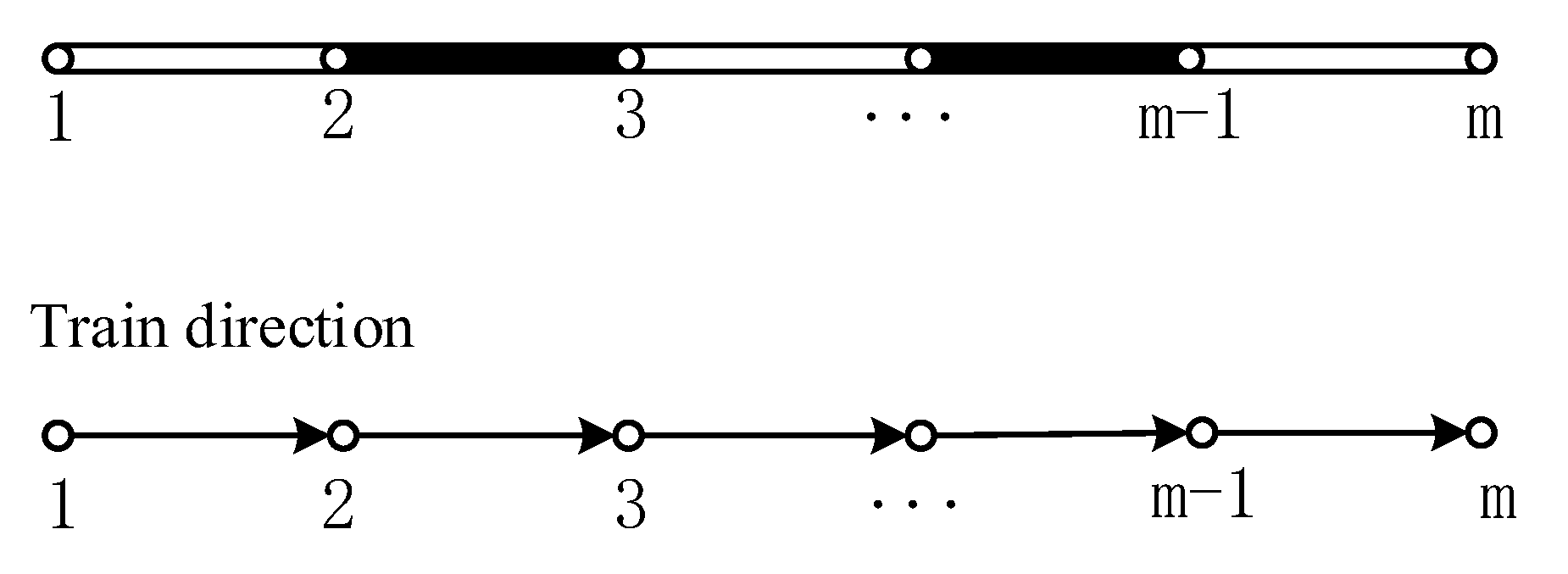

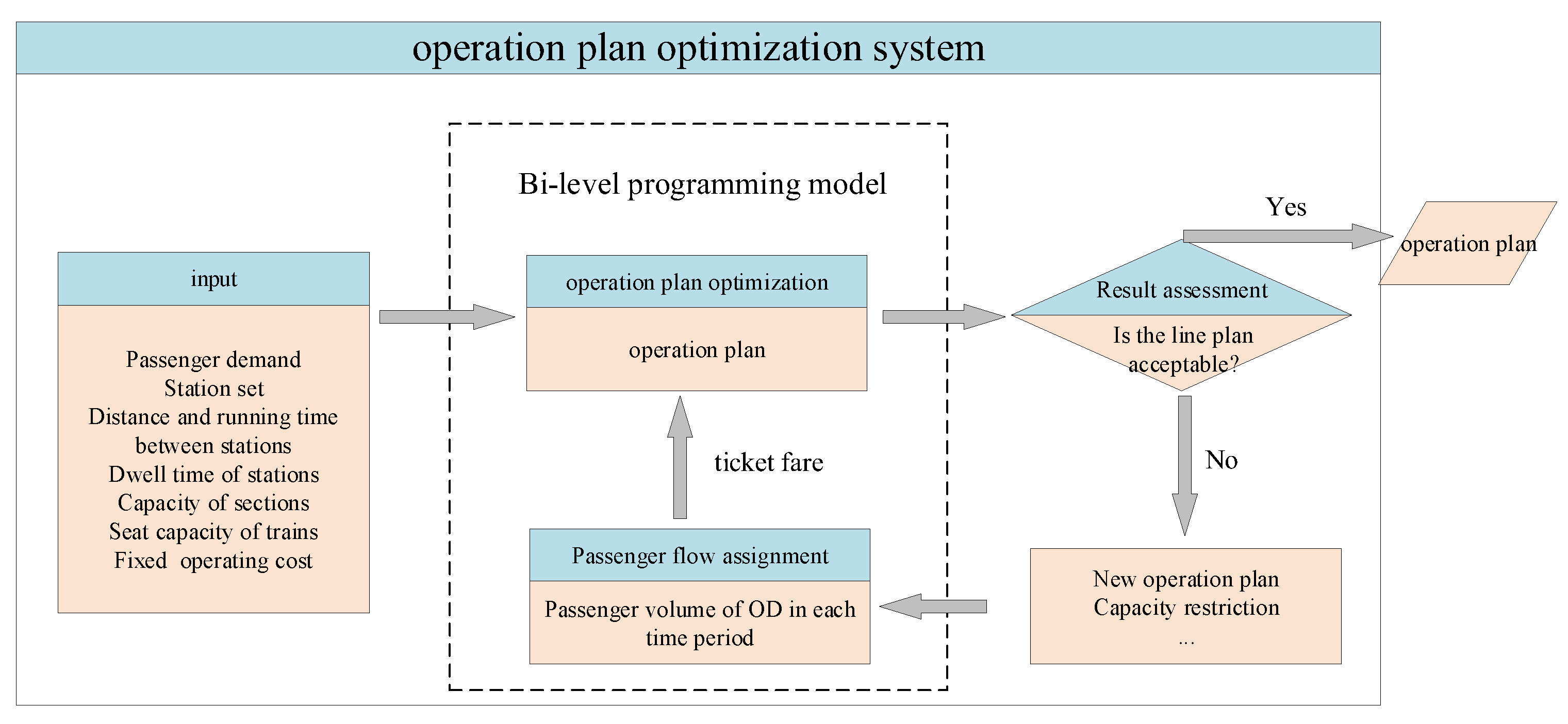

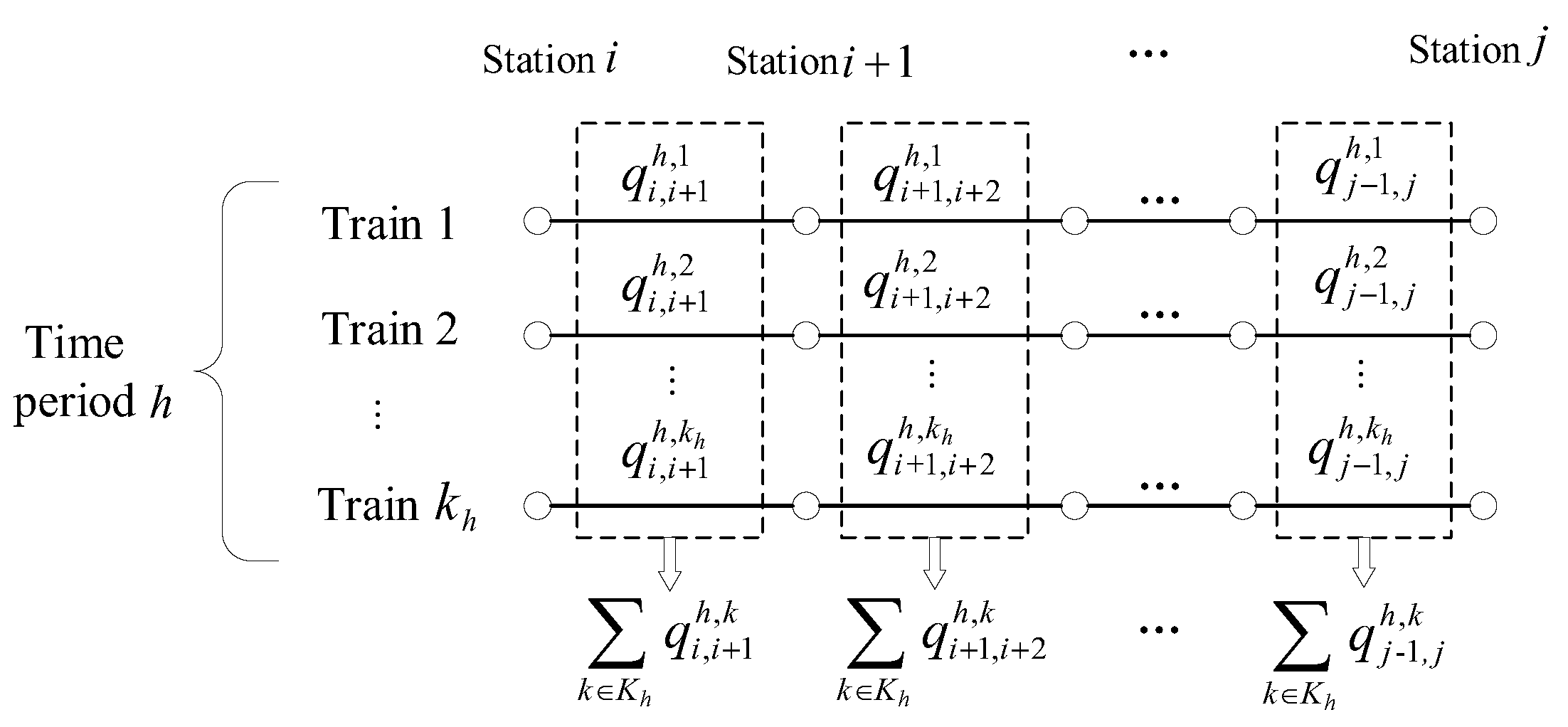
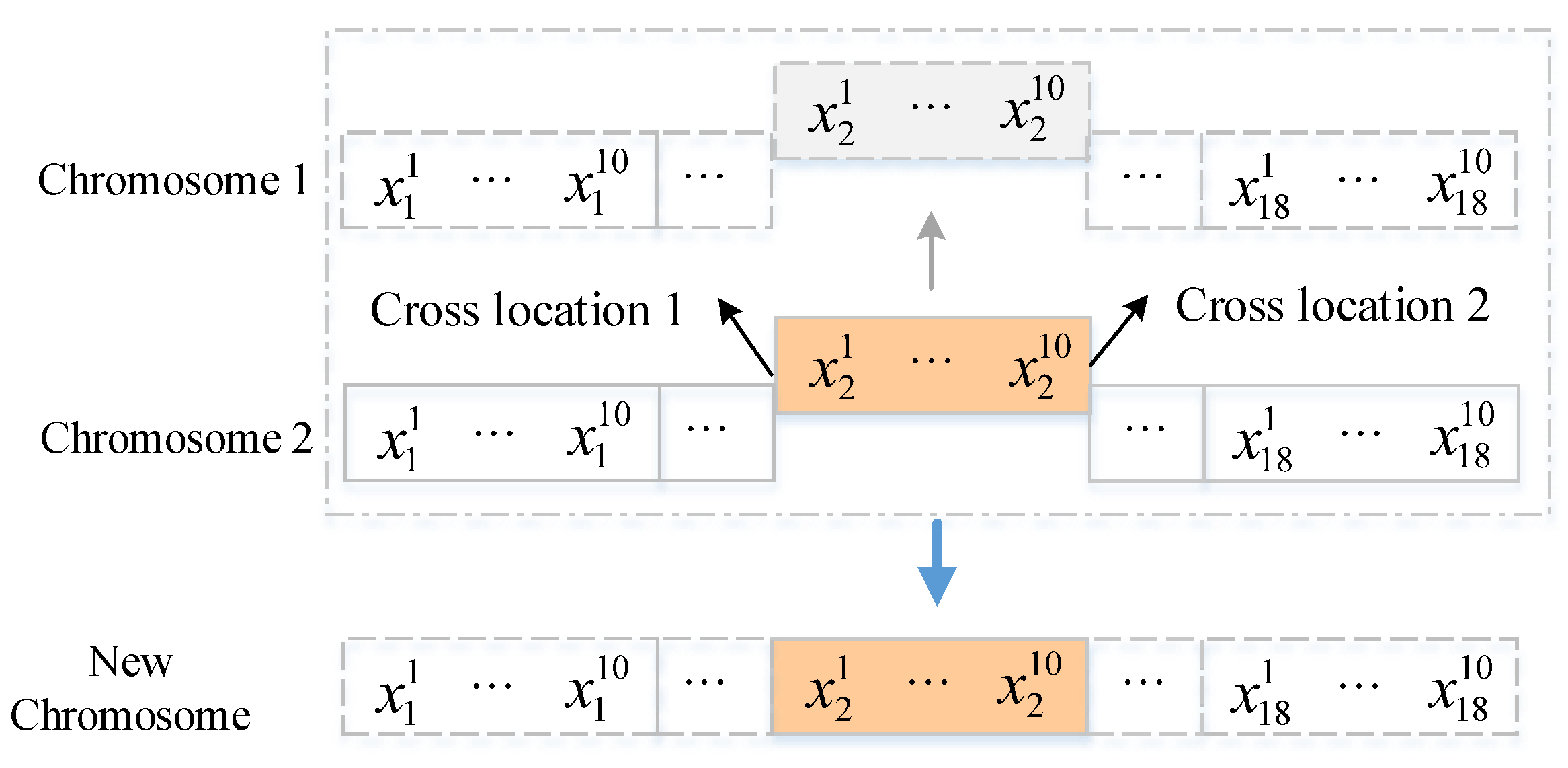
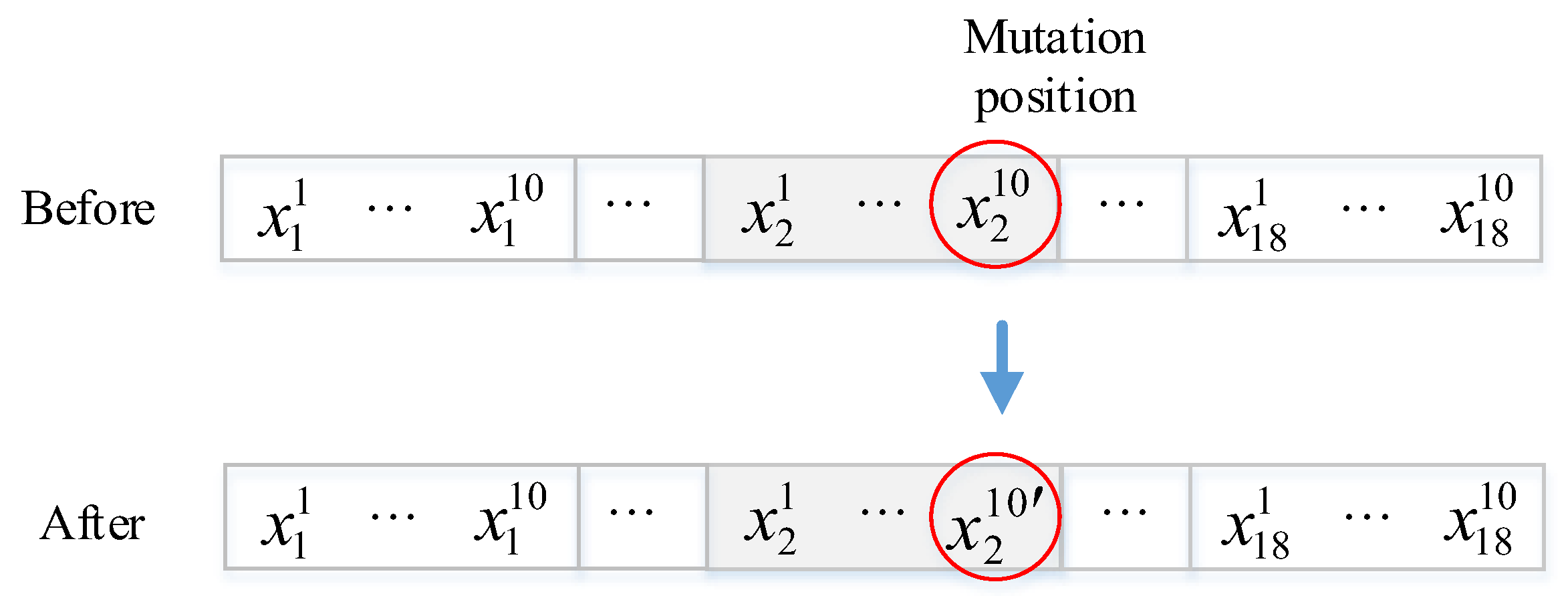


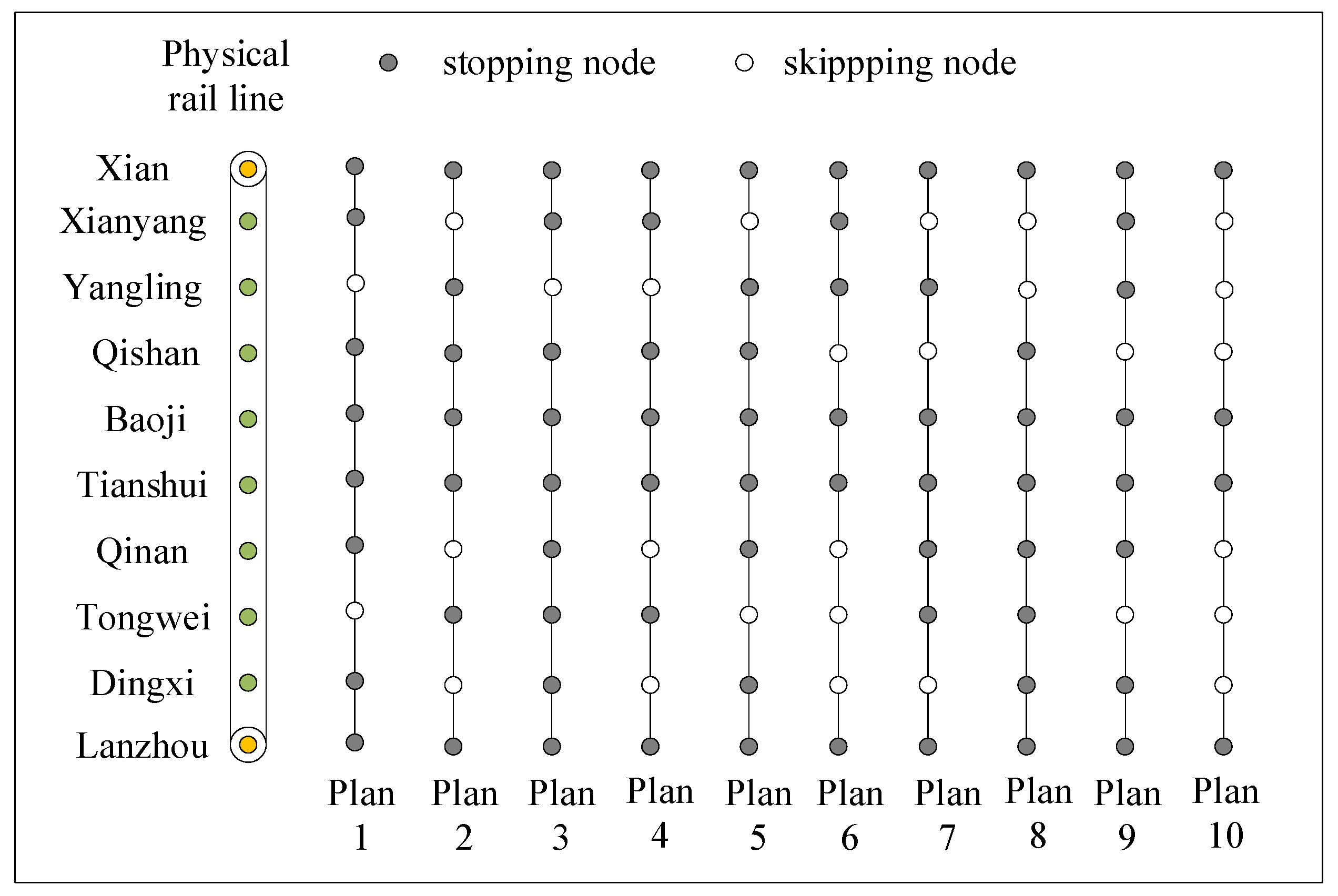
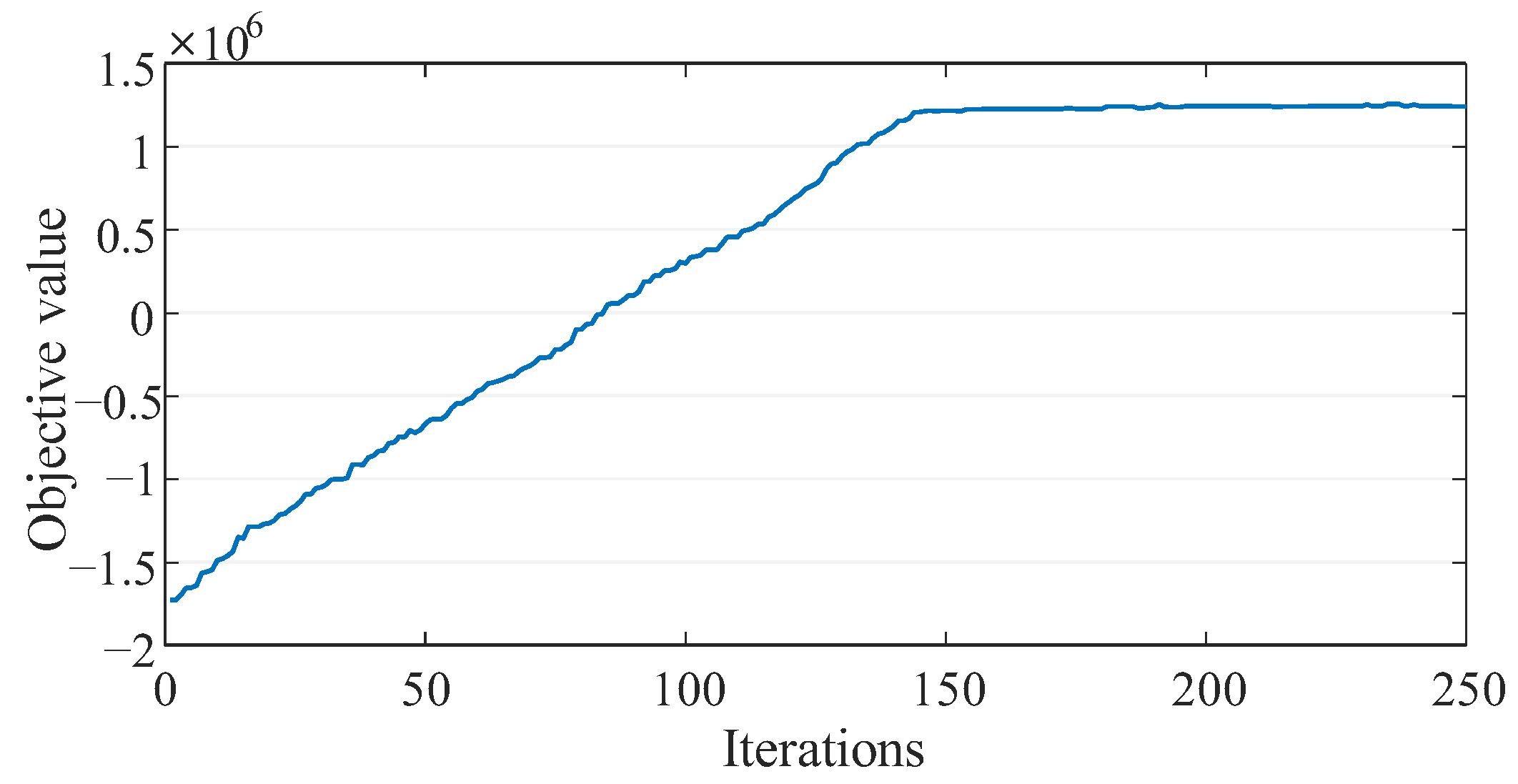

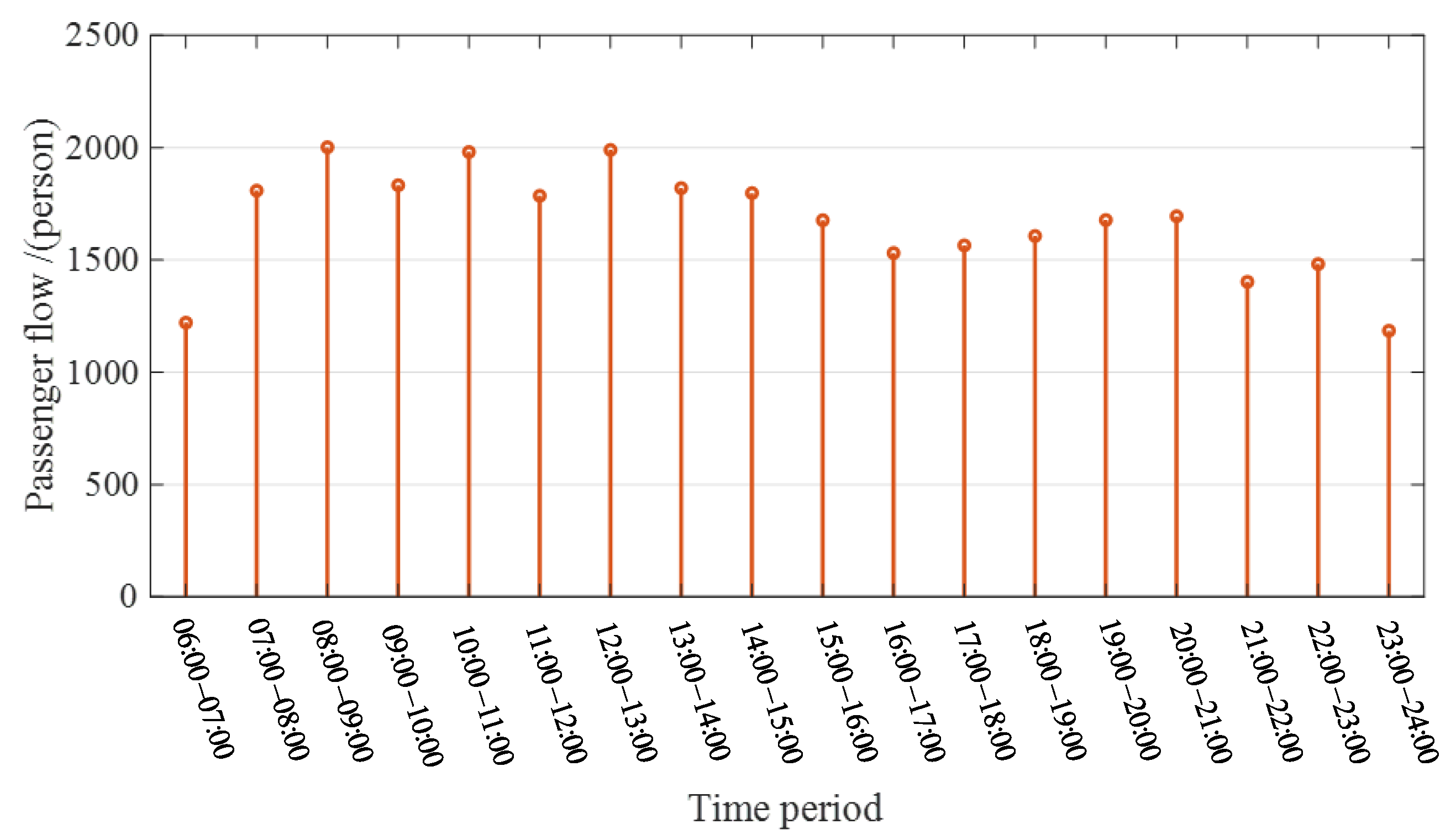


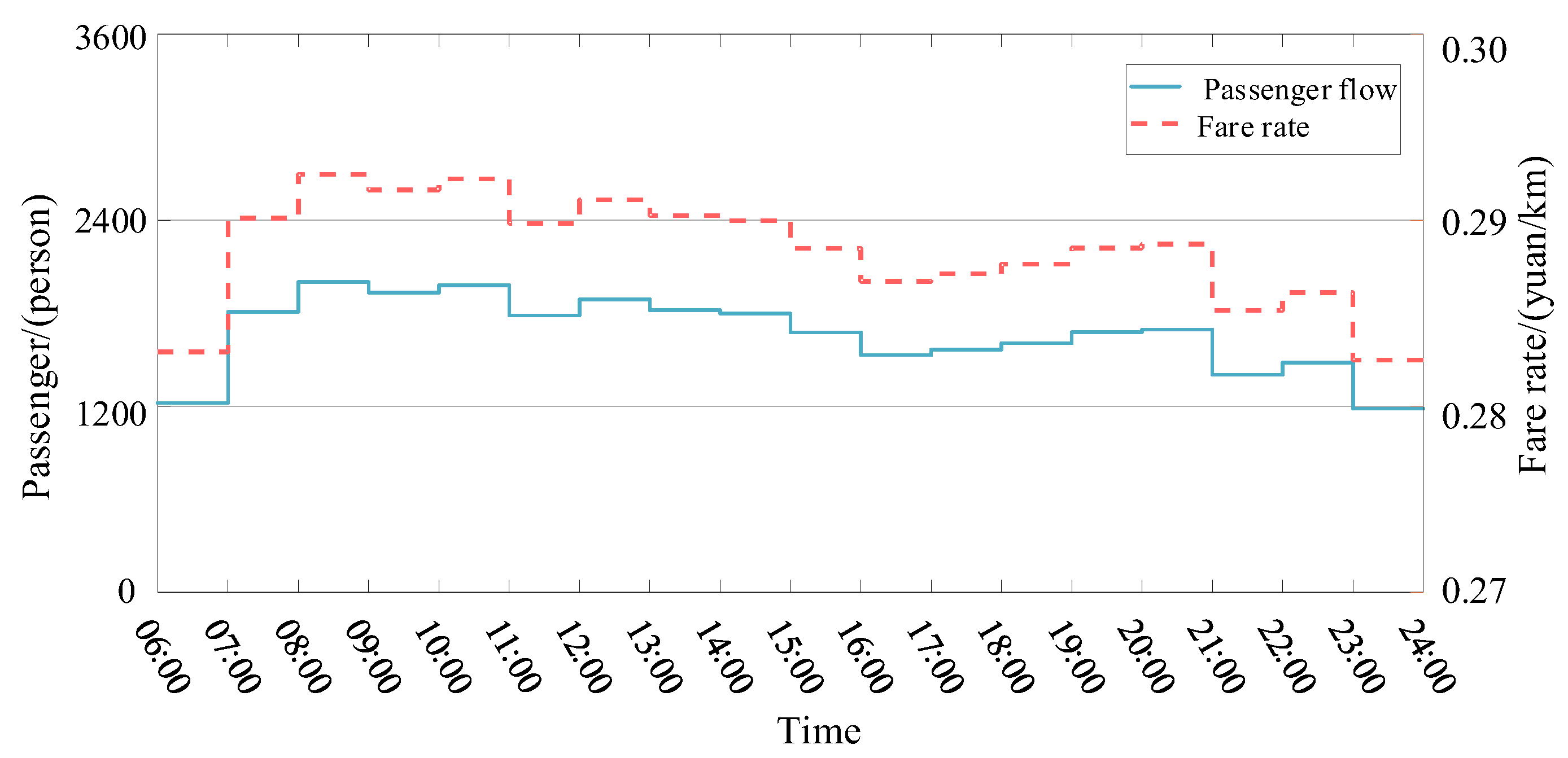
| Indexes | |
| indexes representing the nodes. | |
| indexes representing the time periods. | |
| index representing the parking plan at a node. index representing the trains. | |
| Sets | |
| the set of nodes. | |
| the set of ODs. | |
| the set of train operation time periods. | |
| the set of stop plans. the set of trains that depart from the initial station in time period . the number of elements in . | |
| the convenience cost of a departure from node in time period . | |
| the in-node cost of taking train from node to node in time period . | |
| the in-train cost of taking train from node to node in time period . | |
| Parameters | |
| the maximum number of trains per time period. | |
| the number of seats per train. | |
| 0–1 variable, it determines whether the train with a stop plan of is parked at both node and node . | |
| the cost of running a train with a stop plan of . | |
| time value of passengers. adjustment factor. | |
| convenience factor of node . | |
| total passenger flow between node and node in one day. | |
| the maximum service capacity of the high-speed rail corridor in one time period. | |
| maximum train turnover rate. | |
| higher fare rate. | |
| lower fare rate. | |
| distance between node and node . | |
| total stop time of the train from node to node in time period . | |
| Decision variables | |
| the number of trains running with p-stop plans in time period . | |
| the number of passengers in train from node to node in time period . | |
| Auxiliary variables | |
| fare from node to node in time period . | |
| total number of passengers traveling in time period . | |
| 0–1 variable that determines whether the train is parked at both node and node in time period . | |
| the number of passengers on the train in the interval during time period . | |
| the number of trains arriving at node with stop plan departing from time period to time period . |
| A-B | B-C | C-D | D-E | E-F | F-G | G-H | H-I | I-J |
|---|---|---|---|---|---|---|---|---|
| 105 | 85 | 64 | 51 | 139 | 44 | 51 | 68 | 44 |
| O/D | B | C | D | E | F | G | H | I | J |
|---|---|---|---|---|---|---|---|---|---|
| A | 547 | 674 | 562 | 1096 | 1071 | 1124 | 889 | 1124 | 2020 |
| B | - | 300 | 562 | 449 | 300 | 612 | 112 | 350 | 562 |
| C | - | - | 675 | 512 | 675 | 137 | 337 | 175 | 450 |
| D | - | - | - | 750 | 675 | 437 | 637 | 312 | 150 |
| E | - | - | - | - | 749 | 675 | 412 | 187 | 2622 |
| F | - | - | - | - | - | 375 | 562 | 562 | 1498 |
| G | - | - | - | - | - | - | 687 | 687 | 375 |
| H | - | - | - | - | - | - | - | 887 | 749 |
| I | - | - | - | - | - | - | - | - | 687 |
| 0.228 | 0.2 | 0.266 | 0.24 | 0.2 | 0.226 | 0.25 | 0.23 | 0.28 |
| 40 | 20 | 600 | 7200 | 0.356 | 1.2 | 0.328 |
| 0.268 | 200 | 50 | 10 | 0.85 | 0.85 | 0.05 |
Disclaimer/Publisher’s Note: The statements, opinions and data contained in all publications are solely those of the individual author(s) and contributor(s) and not of MDPI and/or the editor(s). MDPI and/or the editor(s) disclaim responsibility for any injury to people or property resulting from any ideas, methods, instructions or products referred to in the content. |
© 2023 by the authors. Licensee MDPI, Basel, Switzerland. This article is an open access article distributed under the terms and conditions of the Creative Commons Attribution (CC BY) license (https://creativecommons.org/licenses/by/4.0/).
Share and Cite
Wang, J.; Zhao, W.; Liu, C.; Huang, Z. A System Optimization Approach for Trains’ Operation Plan with a Time Flexible Pricing Strategy for High-Speed Rail Corridors. Sustainability 2023, 15, 9556. https://doi.org/10.3390/su15129556
Wang J, Zhao W, Liu C, Huang Z. A System Optimization Approach for Trains’ Operation Plan with a Time Flexible Pricing Strategy for High-Speed Rail Corridors. Sustainability. 2023; 15(12):9556. https://doi.org/10.3390/su15129556
Chicago/Turabian StyleWang, Jianqiang, Wenlong Zhao, Chenglin Liu, and Zhipeng Huang. 2023. "A System Optimization Approach for Trains’ Operation Plan with a Time Flexible Pricing Strategy for High-Speed Rail Corridors" Sustainability 15, no. 12: 9556. https://doi.org/10.3390/su15129556





